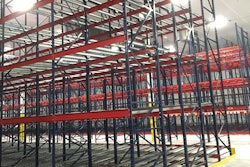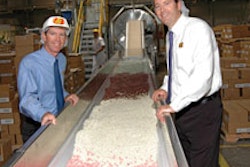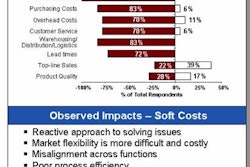Whether operating an existing warehouse or preparing for a new distribution center, an efficient slotting plan developed from an in-depth slotting analysis is an essential element of effective distribution center and warehouse operations. Properly slotting a facility reduces expensive labor costs and dramatically improves throughput by increasing pick and replenishment efficiencies, increasing order accuracy, and reducing ergonomic risks associated with improper picking and replenishment operations. A successful slotting plan also improves the capability to meet inventory rotation requirements, such as FIFO (First In First Out) and LIFO (Last In First Out).
When discussing effective slotting, the focus should be on determining the level at which the product will be picked (full pallet, case pick or piece pick), the storage medium from which product will be picked (pallet rack, shelving, carton flow, etc.), the tools that will be utilized to facilitate the order picking process (paper pick sheets, voice-directed picking, pick to light, etc), and the method of picking to be executed. The primary consideration when conducting a slotting analysis and making these determinations is a company's SKU or product data. SKU information such as product dimension, weight and on-hand quantity are all key factors when determining the proper storage medium and handling methodology.
Though getting your hands around the collection of the full range of product data for each SKU may appear to be a daunting task (especially for organizations that distribute thousands of SKUs), recent advances in technology have greatly simplified the data acquisition and manipulation phase of the slotting analysis. One such technology used by a number of companies has the capability to not only calculate the length, height width and weight of an item, but will also feed these data records directly into a mainframe or PC host. The tasks of collecting and entering the dimension data can be completely automated, resulting in a significant reduction in the time, cost, labor and potential human error that would normally be associated with performing the tasks manually.
SKU Velocity
Another important factor in the slotting analysis is the SKU or product velocity. Product velocity refers to the quantity and frequency of the SKU picked over a designated period of time. Some rules of thumb when considering the velocity of a SKU are:
Attempting to effectively slot your distribution center or warehouse requires careful consideration of many factors and is frequently made more complex by incomplete and/or inaccurate order fulfillment data. Good data lead to positive results; bad or incomplete data to poor results. Some common oversights often made by supply chain professionals when developing a slotting plan on their own:
Though it may sound like future expansion of a slotting system in an existing building can be a major headache at best — and futile at worst — that's not always the case. You may have space you don't even know about. Space limitation can often be dealt with by offsite storage. You can also make sure there aren't a large number of empty pallets hanging around, eating up valuable (and costly) square-footage.
Designing around the System
Ultimately, the perfect (though not always practical) scenario for effectively slotting a warehouse or distribution center is to fit it into preexisting plans for a new structure, to design your building around the material handling system you want (if not now, then for future growth), rather than designing the material handling system around the building. It's not as easy as it sounds. The per-square-foot budget allocation for construction of the building is what drives the train. Planners often lose sight of the reason for the new building, and the material handling system is frequently a last-minute consideration. As the old cliché goes, they are unable to see the forest for the trees.
Whether designing an effective slotting system from scratch or working within existing structural confines, the key to developing a successful slotting strategy is an in-depth understanding of product characteristics and movement. All you have to do is look at the beer industry to know how true this is.
Years ago, when there were only a handful of different types of beers, most goods were shipped in full pallets. But this is more difficult today. With consumer demands constantly changing and the introduction of microbreweries, there are literally hundreds of different beer products, which involve more sorting, more slotting and more labor.
All this has created new and ever evolving challenges with the way we do business. The people who oversee the day-to-day operation of a bustling warehouse or distribution center are often too busy to implement or analyze the changes needed, no matter how rudimentary they may seem. But supply chain professionals who know how to effectively slot their facility will possess a considerable and lasting economic advantage.
About the Authors: Paul Hansen is a senior project engineer for Lakeland, Fla.-based TriFactor, an integrator of material handling systems. He has over 10 years experience in the industry and holds a B.S. in mechanical engineering from the University of South Florida. He can be contacted at [email protected].
Kelvin Gibson is a project engineer for TriFactor. He holds a degree in industrial engineering from the University of Central Florida. He can be reached at [email protected]. For more information on TriFactor, visit www.trifactor.com.
When discussing effective slotting, the focus should be on determining the level at which the product will be picked (full pallet, case pick or piece pick), the storage medium from which product will be picked (pallet rack, shelving, carton flow, etc.), the tools that will be utilized to facilitate the order picking process (paper pick sheets, voice-directed picking, pick to light, etc), and the method of picking to be executed. The primary consideration when conducting a slotting analysis and making these determinations is a company's SKU or product data. SKU information such as product dimension, weight and on-hand quantity are all key factors when determining the proper storage medium and handling methodology.
Though getting your hands around the collection of the full range of product data for each SKU may appear to be a daunting task (especially for organizations that distribute thousands of SKUs), recent advances in technology have greatly simplified the data acquisition and manipulation phase of the slotting analysis. One such technology used by a number of companies has the capability to not only calculate the length, height width and weight of an item, but will also feed these data records directly into a mainframe or PC host. The tasks of collecting and entering the dimension data can be completely automated, resulting in a significant reduction in the time, cost, labor and potential human error that would normally be associated with performing the tasks manually.
SKU Velocity
Another important factor in the slotting analysis is the SKU or product velocity. Product velocity refers to the quantity and frequency of the SKU picked over a designated period of time. Some rules of thumb when considering the velocity of a SKU are:
- Determine fast, medium and slow movers and place them in the appropriate storage medium (i.e. pallet flow, carton flow, shelving, etc.).
- Examine both average and peak-picking days.
- Store high-velocity SKUs in a readily accessible and ergonomically friendly area for ease of both picking and replenishment.
- Establish whether individual SKU velocities are affected by seasonality or special promotions.
Attempting to effectively slot your distribution center or warehouse requires careful consideration of many factors and is frequently made more complex by incomplete and/or inaccurate order fulfillment data. Good data lead to positive results; bad or incomplete data to poor results. Some common oversights often made by supply chain professionals when developing a slotting plan on their own:
- Not designing a system with sufficient flexibility to accommodate changing SKU's or space needs — a fatal flaw for companies dealing with continuously changing SKU velocities or experiencing significant growth within the three- to five-year horizon.
- Not taking the characteristics of their product into consideration. When slotting, the velocity of a SKU must be considered in order to increase pick and replenishment efficiencies. Size and weight of the product must also be taken into consideration to ensure proper pallet or load building.
- Not providing a clear path for pickers. A congested route not only poses a safety hazard, but also increases the time needed for an employee to fill an order.
- Not choosing the proper storage medium for each SKU. The characteristics of each SKU (SKU data) should be the primary consideration when choosing the storage medium for a particular SKU. Choosing storage medium based on other factors often proves to be an expensive mistake.
Though it may sound like future expansion of a slotting system in an existing building can be a major headache at best — and futile at worst — that's not always the case. You may have space you don't even know about. Space limitation can often be dealt with by offsite storage. You can also make sure there aren't a large number of empty pallets hanging around, eating up valuable (and costly) square-footage.
Designing around the System
Ultimately, the perfect (though not always practical) scenario for effectively slotting a warehouse or distribution center is to fit it into preexisting plans for a new structure, to design your building around the material handling system you want (if not now, then for future growth), rather than designing the material handling system around the building. It's not as easy as it sounds. The per-square-foot budget allocation for construction of the building is what drives the train. Planners often lose sight of the reason for the new building, and the material handling system is frequently a last-minute consideration. As the old cliché goes, they are unable to see the forest for the trees.
Whether designing an effective slotting system from scratch or working within existing structural confines, the key to developing a successful slotting strategy is an in-depth understanding of product characteristics and movement. All you have to do is look at the beer industry to know how true this is.
Years ago, when there were only a handful of different types of beers, most goods were shipped in full pallets. But this is more difficult today. With consumer demands constantly changing and the introduction of microbreweries, there are literally hundreds of different beer products, which involve more sorting, more slotting and more labor.
All this has created new and ever evolving challenges with the way we do business. The people who oversee the day-to-day operation of a bustling warehouse or distribution center are often too busy to implement or analyze the changes needed, no matter how rudimentary they may seem. But supply chain professionals who know how to effectively slot their facility will possess a considerable and lasting economic advantage.
About the Authors: Paul Hansen is a senior project engineer for Lakeland, Fla.-based TriFactor, an integrator of material handling systems. He has over 10 years experience in the industry and holds a B.S. in mechanical engineering from the University of South Florida. He can be contacted at [email protected].
Kelvin Gibson is a project engineer for TriFactor. He holds a degree in industrial engineering from the University of Central Florida. He can be reached at [email protected]. For more information on TriFactor, visit www.trifactor.com.












